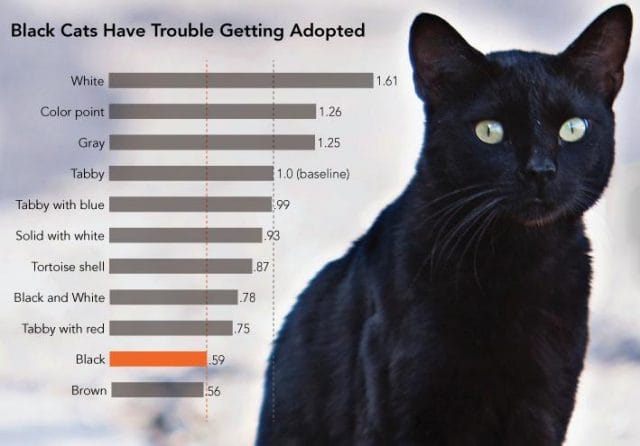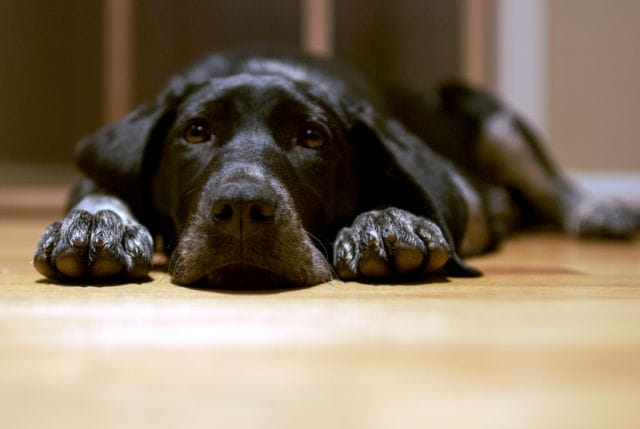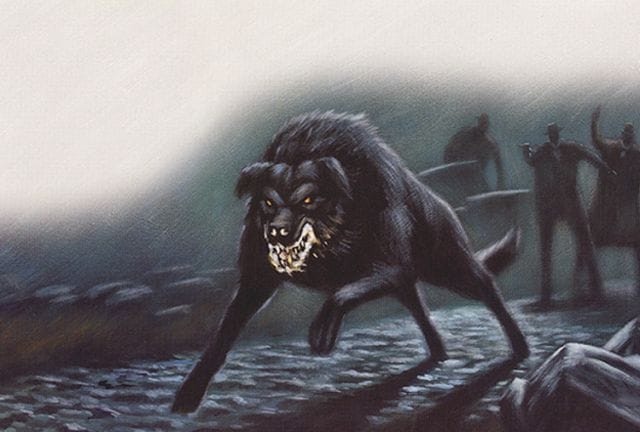It has long been publicised that older (5+ year old) animals are the last to be adopted and the first to be euthanized at shelters. But the color of an animal’s fur is almost as stigmatized — especially for black-coated pets.
This holds so true for black dogs, that a condition exists to describe the phenomenon — Big Black Dog Syndrome; animal shelters use the term “BBD” to reference the larger, mixed-breed black dogs typically shunned by potential adopters. Black cats face an equally formidable bias: they are far less-likely to be adopted than grey, tabby, and white-coated cats, and have been castigated as “evil omens” for decades. But what are the reasons behind this?
Big Black Dog Syndrome
A myriad of theories attempt to address the bias against black dogs — particularly those of the larger variety. Jacque Lynn Schultz, ASPCA’s shelter outreach director told People that most adopters feel black dogs “look menacing because their facial expressions are harder to read.” Amy Chase of the Ohio County Animal Shelter in Rising Sun, Ind., adds that “the black dog is definitely more at risk of going to death row than a yellow or tan dog.” While little numerical data exists to quantify this issue, it has been explored extensively by researchers.
A 2011 study by the ASPCA found that appearance is the most important factor for adopters, both with puppies (29%), and full-grown dogs (26%); black dogs are consistently listed as the least desirable. In a 2010 study, Animal Shelter Dogs: Factors Predicting Adoption Versus Euthanasia, Wichita State researchers followed the trajectory of 1,468 relinquished dogs available for adoption and found that dogs with black coats were more likely to be euthanized, while dogs with white, gold, and gray coats had significantly higher adoption rates.
The evil, ferocious (and black) hound of Baskerville; Source: AODS
Researchers and shelter workers have suggested several reasons for this. Potential adopters may associate black fur with “evil” or “misfortune;” black dogs have also been stigmatized as aggressive and menacing. In British folklore, black dogs have a long history as “nocturnal apparitions” associated with the Devil. From Arthur Conan Doyle’s The Hound of Baskervilles to Wiltshire’s “Black Dog Hill,” the dark-furred canines are regarded as “portents of death.” These evil dogs are often portrayed as larger than the average dog, “black as the night,” and unequivocally snarlish.
American media has a similar history of demonizing the black dog. In Zoltan, Hound of Dracula (1978), a black dog is possessed by the spirit of Dracula, and terrorizes all who come in contact with him. Kolchak: The Night Stalker, a 70s television show, featured a politician who had the ability to morph into a huge black Rottweiler, complete with a giant pentagram around it’s massive neck and an omnipresent, fang-bearing scowl.
But black dogs face another issue: they’re harder to market. Most shelters feature photos of their animals on a website in an attempt to entice adopters; black dogs are difficult to photograph, and their personalities are often masked in darkness. A 1992 Animal Welfare study presented participants with photographs of different colored dogs: 65% preferred dogs with lighter coats. Anthrozoos published a study in 2013 that found “participants rate yellow dogs significantly higher that black dogs on the personality dimensions of Agreeableness, Conscientiousness, and Emotional Stability.” The same study found that participants considered black dogs the “least friendly” — based solely off of a photograph.
Curse of the Black Cat
Cats face equal challenges in the adoption market, perceived for centuries as cursed. Though some cultures celebrate the black cat as a sign of prosperity and good luck (Japan), the felines have generally been castigated as an evil omen.
In the Middle Ages, when the European church began accusing women of witchcraft, black cats were targeted as witches’ familiars. During the time of the Black Death in the 14th century, the cats were killed “en masse” (some historians speculate this contributed to the proliferation of rats and, consequently, the spread of the plague’s fleas). Scottish folklore featured Cat Sith, a large black cat that had the ability to steal a dead person’s soul. The Scots were so terrified of Sith that they would sit over their deceased relatives’ bodies overnight to ensure that the feline didn’t reap them of eternal bliss.
Similar myths were propagated in America, based on the religious ideals of Pilgrims. Black cats were deemed evil — so much so that anyone caught with one would be severely punished, or killed, under suspect of being a witch. Though these ideals have long since faded, they are perpetuated by folk tales like Black Cat’s Message and Wait Until Emmet Comes (which feature supernatural black cats disguised as demons) and commercialized as companions of Halloween moons. Some shelters go so far as to prohibit the adoption of black cats in October “for fear the felines would be used as holiday props or, worse, sacrifices for those who practice witchcraft.”
“Black cats are some of the most sleek, clothing-friendly cats. You won’t have little white hairs over everything,” Willow Liroff, head cat volunteer at the Oakland Animal Shelter, told the Chronicle. “But for some reason, they are, hands down, the hardest to find homes for.” Shelters have tried their best to market the cats with catchy campaigns — “Black Is the New Black,” “Adopt a Mini-Panther,” “Black Goes With Everything,” “Back in Black” — but have seen little success.

Black cats are more than three times less likely to be adopted at shelters; Source: Huffington Post
A UC Berkeley study asked 189 people about their opinions on cats, based on fur color. Respondents listed orange cats as “friendly,” tortoiseshell cats as “intolerant and aloof,” and white cats as “shy,” but expressed negative opinions (or a complete lack of opinion) toward black cats. Shelter staffers routinely make it known that black cats take much longer to be adopted, and are the most commonly euthanized. Similarly, a 2002 study in the Journal of Applied Animal Welfare Science found that black cats were far less-likely to be adopted, solely based on their fur color.
Pet Equality
ASPCA Vice President of Shelter Research Dr. Emily Weiss brushes off the black pet adoption disparity as fiction. “People might see that black [pets] are staying around longer, but that might just be because there are more black [pets] in the shelters,” she told Today. “I think some beliefs are hard to change, especially if someone has anecdotal evidence that there have been one or two big black dogs that take longer to adopt.”
But a vast swath of researchers and adoption workers maintain that the issue is both prevalent and real. “For whatever reason, black animals don’t catch people’s attention as much,” Humane Society worker Tyler Stover told a CNN affiliate. His shelter has gone to great lengths to mitigate the problem, offering black pets at 50% discounts, and even giving them away for free on Black Friday.
Others have pursued creative means to end “pet discrimination.” Fred Levy, a photographer, launched the Black Dogs Project, a photo series intended to highlight the oft-overlooked beauty of black dogs and raise awareness of their adoption neglect. Boston-based non-profit Black Cat Rescue offers an adoption service exclusively for black cats, and informs potential adopters of their merits.
Black pets are ultimately part of a larger issue: between 3 and 4 million cats and dogs are euthanized each year in the U.S. — nearly 50% of all sheltered animals.
This post was written by Zachary Crockett. Follow him on Twitter here, or Google Plus here.






